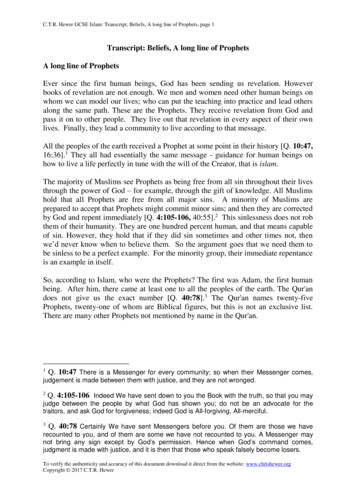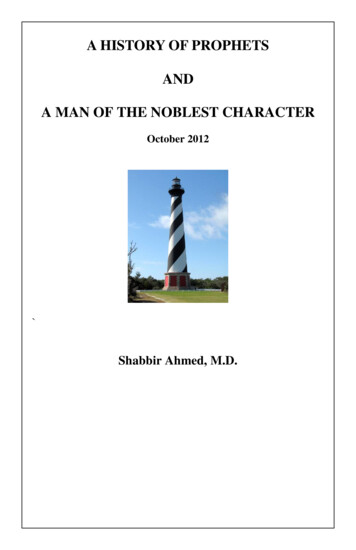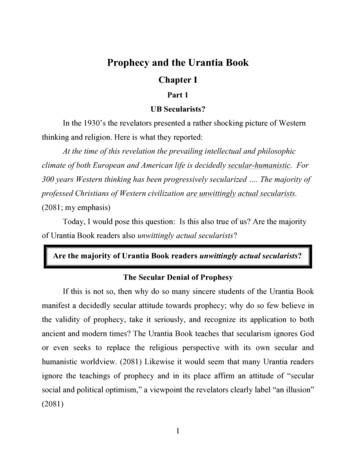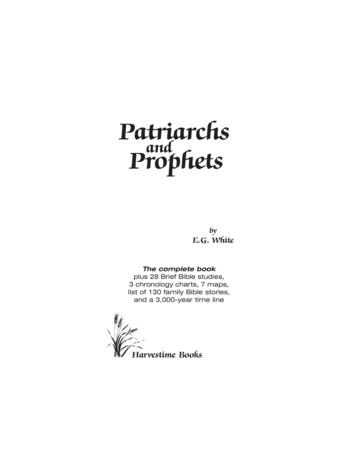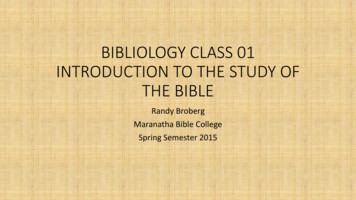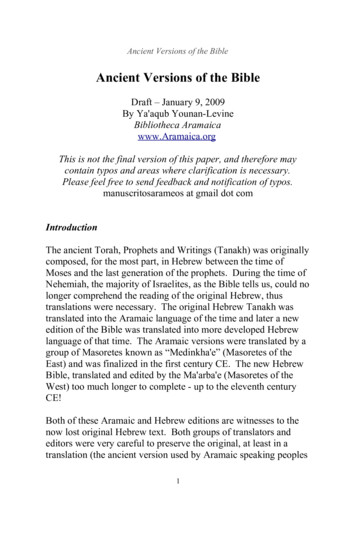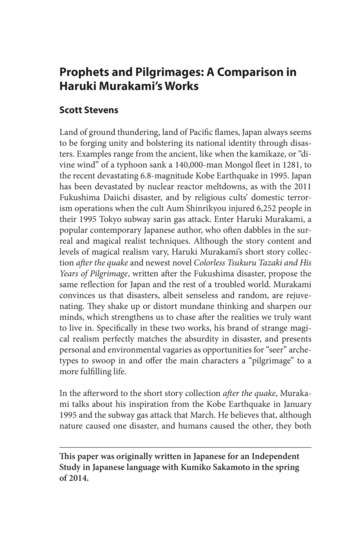
Transcription
Prophets and Pilgrimages: A Comparison inHaruki Murakami’s WorksScott StevensLand of ground thundering, land of Pacific flames, Japan always seemsto be forging unity and bolstering its national identity through disasters. Examples range from the ancient, like when the kamikaze, or “divine wind” of a typhoon sank a 140,000-man Mongol fleet in 1281, tothe recent devastating 6.8-magnitude Kobe Earthquake in 1995. Japanhas been devastated by nuclear reactor meltdowns, as with the 2011Fukushima Daiichi disaster, and by religious cults’ domestic terrorism operations when the cult Aum Shinrikyou injured 6,252 people intheir 1995 Tokyo subway sarin gas attack. Enter Haruki Murakami, apopular contemporary Japanese author, who often dabbles in the surreal and magical realist techniques. Although the story content andlevels of magical realism vary, Haruki Murakami’s short story collection after the quake and newest novel Colorless Tsukuru Tazaki and HisYears of Pilgrimage, written after the Fukushima disaster, propose thesame reflection for Japan and the rest of a troubled world. Murakamiconvinces us that disasters, albeit senseless and random, are rejuvenating. They shake up or distort mundane thinking and sharpen ourminds, which strengthens us to chase after the realities we truly wantto live in. Specifically in these two works, his brand of strange magical realism perfectly matches the absurdity in disaster, and presentspersonal and environmental vagaries as opportunities for “seer” archetypes to swoop in and offer the main characters a “pilgrimage” to amore fulfilling life.In the afterword to the short story collection after the quake, Murakami talks about his inspiration from the Kobe Earthquake in January1995 and the subway gas attack that March. He believes that, althoughnature caused one disaster, and humans caused the other, they bothThis paper was originally written in Japanese for an IndependentStudy in Japanese language with Kumiko Sakamoto in the springof 2014.
2Scott Stevensultimately capsized Japan. “We, on the whole, believe that the groundwe step on is unshakeable. We may even each take it as a ‘self-evidenttruth.’ However, that can suddenly liquefy under our feet those invisible lethal weapons do not distinguish commuters in their attacks”(263). This short story collection was also his first major work featuring third-person narration. The change from first person emphasizesthe main characters’ choices not only as part of a personal journey, butas part of external forces at work. All of the short stories have a maincharacter whom the Kobe Earthquake affects and a “seer” characterwho offers him control over his fate through a journey of sorts, onethat reimagines the character’s pain as a strength and allows him todirect his life towards fulfillment. We’ll start with the short story thatgives the collection its Japanese name, “All of God’s Children Dance.”A reveling youth named Yoshiya is our protagonist who wakes up toa hangover one morning, a mere side effect of the profound transformation he’s just undergone. Flashback to Yoshiya’s conception: Yoshiya’s mother, after “lovelessly fornicating with many men”(94), in highschool, dated a doctor with a missing earlobe, and, despite careful contraceptives, bore his child. The doctor abandoned her, and she foundfaith in a religious sect whose members saw Yoshiya’s as a virgin birth,which meant that he was the Son of God. Growing up, Yoshiya struggled to improve at his passion, baseball. Yoshiya couldn’t believe thathis father was God if his father wouldn’t answer his prayers and helphim become a better baseball player, and so he gave up his religion. After the Kobe earthquake strikes, his mother treks to Western Japan towork as an aid volunteer with her fellow church members. Yoshiya’s response to these events is to ditch work and follow a man in a train witha missing earlobe, believing him to be his estranged biological father.He follows him through an industrial area with glaring mercury streetlights, with which Murakami’s magical realist language works perfectly: “an imaginary scene with no sign of human life around him, looking all together like it was thrown together in a dream” (101). Yoshiyatracks him down near an enormous, “unfriendly” concrete fence withbarbed wire “thickly surrounding the top of it as if daring the world”containing a scrapyard with heaps of cars. The man goes into a dark al-
THE MENLO ROUNDTABLE3leyway, and “although Yoshiya was a little hesitant, he still followed theman and set his foot into the twilight”(102). This screams of a hero’sjourney. When Yoshiya wriggles through a hole at the end of the alleyand finds himself in a baseball field, the man nowhere to be found, werealize that this typically magical realist “unexplainable” disappearancereveals the search for his “father” as a pretense for Yoshiya to arrive atthe destined field. Alone there, Yoshiya remembers his relationshipsso far in his life, all of which seem to have been essentially sensualand centered around dancing. He recalls what a good dancer he hasbecome through dancing with these partners as he dances by himselfin the field. Feeling connected with the world, he becomes aware of hispotential as a force for good, a realization parallel to his mother’s experience of sexuality and its deeper significance. For his mother, it wasgiving birth; for Yoshiya, it is club dancing. Both of these lead them tofind God. His mother found religion, and at the end, Yoshiya whispers,“God.” The hope and possible salvation in Yoshiya wouldn’t have occurred had the Kobe earthquake not happened, shaking his connections to his mother, his father, and to his sense of purpose.In another short story, “Superfrog Saves Tokyo,” a human-sized frogenlists everyday loan collector, Katagiri, to stop a massive subterranean worm from destroying Tokyo as it did Kobe. What makes themagical realism so potent is the polite and non-assuming way the frog,Kaeru, talks to Katagiri: “I ought to have made an appointment beforecoming ”(153). Strange, but it charms the reader as it charms Katagiri. Katagiri, like most of Murakami’s characters, is a loner who doeshis best to deal with his humdrum days of collecting loans in the midstof Chinese mafiosos and the Yakuza. His life reflects post-bubble Japan’s economic and spiritual depression. However, Kaeru comes as the“seer” character to lead Katagiri to new meaning by battling the worm.On his way to their meeting place, Katagiri gets shot unconscious,only waking up in a hospital to find Kaeru congratulating him on theirbattle, which happened in a dream world underground. Kaeru saysthat the worm wounded him and that he feels an “anti-self ” (165), theentropy in his heart, overtaking him, so he rests but is then consumedby a swarm of bugs that envelop the whole hospital room. Katagiri
4Scott Stevenswakes up and is distraught by Kaeru’s death, but takes strength from itand realizes he can battle his own “anti-self ” in the real world, and fallsback into a dreamless sleep.The final story in the collection, “Honey Pie,” is about a shy but increasingly successful short story writer named Junpei who has helpedraise a female child named Sala with his longtime love from college,Sayoko. The problem is that Sayoko was married to their friend Takatsuki, a man she did not love, until Sala was two years old. This situation was partly a result of Junpei’s inability to articulate his feelingsfor Sayoko. “Honey Pie” begins with master storyteller, Junpei, tellingSala a story about a bear named Masakichi who made money sellinghoney, whom all the other bears hated. One particularly jealous bearwas Tonkichi. In this case, Masakichi is the “seer” character, as he isJunpei’s guide to finding the courage to propose to Sayoko at the endof the story. The three of them go to a zoo the next day to see the bears,and Junpei finishes his story to Sala. Tonkichi trades salmon with Masakichi for honey, and they become friends, but Tonkichi gets capturedand sold to the zoo. That night, Sayoko and Junpei sleep together, andJunpei decides to tell and write hopeful conclusions, with Tonkichibaking honey pies from the zoo to send to Masakichi so they can stillbe friends. Masakichi’s story prompts him to propose to Sayoko thenext morning. The Kobe earthquake initiates this because Sala, afterwatching Kobe’s destruction on the news, begins to have nightmaresabout an “Earthquake Man” who comes with tiny boxes, waiting tosqueeze them into the boxes. Metaphorically, of course, it representssocial expectations and destiny, but here lies an opportunity to rejectthem. Junpei decides he is tougher than social conventions, that “nomatter who it is, they won’t force [him] into meaningless boxes. Evenif the sky falls down, even if the ground roars open”(237). The earthquake has strengthened him.In comparison, Colorless Tsukuru Tazaki and His Years of Pilgrimagecontains a longer journey, one centered on a personal disaster for themain character, Tsukuru. In high school, Tsukuru was part of an inseparable five-person group, two girls and three boys. All of them hadnames containing colors, except for Tsukuru, which means “to make”
THE MENLO ROUNDTABLE5in Japanese. Compared to his group of friends—which included a rugby player, a genius, a piano virtuoso, and a hilarious comedian—Tsukuru always felt uninteresting for his favorite pursuit, train station engineering. His friends stayed in their hometown, Nagoya, while Tsukuruwent to Tokyo to study his passion. When he returns one college break,mysteriously, none of them answer his calls, and he realizes that theywant nothing to do with him anymore. This hits him like a sarin gasterrorist attack, sending him into the depression about which the novelbegins, “From July in his sophomore year to January of the followingyear, Tsukuru Tazaki lived thinking almost only about death”(3). Thenthe title reveals its meaning; Tsukuru worries if it was his “colorlessness” that caused his friends to abandon him.With his health spiraling downward, Tsukuru descends into depression for five months, and comes out of it when he starts using the localgym and its pool. There, he begins to swim with an underclassmannamed Haida who inspires in Tsukuru a passion for classical musicand philosophy. Haida’s name in Japanese contains the word “grey,”implying his wisdom for recognizing Tsukuru’s strengths, like when henotices that Tsukuru “likes to build things like [his] name”(53).Thelong, 1500-meter slogs Haida leads Tsukuru through represent Tsukuru’s first journey in pulling strength from his psychological nightmare. After swimming, “again all the important muscles grew back, hisspine stretched straighter, and even the color returned to his face theboy once named Tsukuru Tazaki was dead”(60). Haida shows Tsukuruhow to liberate his soul during one of their long midnight conversations. Haida says that he “wants to live a free life, the kind he can gowhere [he] wants when [he] wants, thinking only about the things [he]wants to”(63). Tsukuru admires Haida and this “freedom of thought.”However, Haida warns Tsukuru that to learn to think for himself “isas hard as dreaming intentionally. Normal people can’t pull it off ”(63).In fact, this process is “the same as mastering a new language, putting its usage to heart.” Murakami furthers Haida’s position as a seerwhen Haida describes how prophets bring messages that people canuse for “rebellion” against their thoughts and the “frames” or limitations of existence. The two then listen to Franz Liszt’s “Le Mal du Pays”(Homesickness), on a record named with the book’s title, “The Years
6Scott Stevensof Pilgrimage.” Haida describes it having “a sadness without reason,”a similar sensation to Tsukuru’s feelings when his friends abandonedhim. In their friendship, Haida prepares Tsukuru for his journey torecover his friends by teaching him independence. He, too, disappearsmysteriously one day, but this time, Tsukuru is stronger, and continueson his life for years before meeting his next “seer.”Now cozy in his train station engineering job, Tsukuru drifts throughrelationships and life quietly. That is, until a woman he starts dating,Sara, gives him an ultimatum; he needs to connect with his four pastfriends, or he’ll never see her again. Again, she acts as a wise figure whosees Tsukuru’s buried pain and his past relationship troubles it caused.She knows that, to love another, one must love oneself. Sara hunts forthe friends’ contact information on the Internet, and sends Tsukuru offon his pilgrimage to excavate his past. At that point, Tsukuru discoversa terrible hidden truth. One of his female friends was raped, and shehad told the rest of their group that Tsukuru had done it. This is whatprompted them to cut off all connections with him. The girl was foundmurdered in an apartment some years later.Shocked, Tsukuru goes from Nagoya to Finland to reconcile with eachof the remaining three friends. He learns that to his friends, he wasn’tthe dull, colorless person he imagined himself to be, but rather, likethe web of subways he watches and builds, he was their connector, the“ship’s anchor” that held the group down. He made them “feel safe when [he] was with [them, they] felt their natural selves” (221). Thegirl living in Finland confesses she liked him because of this. One of thefriends felt Tsukuru was the “handsome boy that all the parents loved.”Another friend reveals that after he left for Tokyo, the girl who waslater killed may have been the first to sense their lives’ divergence andthe group’s approaching collapse, and so, feeling trapped, she unconsciously blamed Tsukuru for her assault. Tsukuru realizes the effectshe has had on his loved ones and his worth as a friend. But the readeralso sees that this realization only comes through painful pilgrimages like these. Murakami contrasts Tsukuru with one of his friends, aformer rugby player. The friend “was not used to confusion. His trueworth showed on fixed fields, following fixed rules, playing with fixedteammates”(137). Tsukuru, on the other hand, has been dealing with
THE MENLO ROUNDTABLE7absurd puzzles thrown his way in life which has toughened him. Hisfriend notices this, telling Tsukuru he has a “slim, masculine feel to[him. His] cheeks are hollow, and [his] eyes are deep and sharp.” Incomparison, his once athletic friend complains of not being in shapeenough now to comfortably run a mile. Tsukuru sees this and choosesnot to talk about “those days that completely made new his mind andbody even if he told [his friend,] probably not even half of what he’dfelt would get through”(138).In the end, Tsukuru returns to Tokyo and reflects on his relationshipto his family, his past, and his friends. He sits in Shinjuku Station, thebusiest in the world, looks at the random movements of the crowd, andfeels at peace. He is ready to love Sara fully.Doubtless, as someone who can translate The Great Gatsby into ajust-as-powerful Japanese version, Murakami loves language. As a researcher, as a short and long novelist, he knows concision in composition. However, he also adores the wispy, grey characters and wordssliding around our vision. When Tsukuru talks with a woman in Finland, she says to him, “there are things in our lives too hard to explain, no matter what the language”(224). Because of the difficulty inexpressing bizarre events in normal writing, his magical realism andrandom quests seek to copy the real world’s unreal happenings. Mosttangibly, he uses natural disasters like earthquakes in after the quake.But he also explores “unreal” personal disasters. For us humans in anerratic universe, stories are what give us sense.
8Scott StevensScott Stevens’ Prophets and Pilgrimages: A Comparison inHaruki Murakami’s Works - Japanese �ズム ��させた、と
THE MENLO ��状化』してしまう 想のない」コンクリートの塀の
10Scott さのカエルが ローンを集める仕事を
THE MENLO �は �� �いう夢なのです。もちろん象徴
12Scott び必要な
THE MENLO �に伸び、顔にも血色が戻ってきた �ンツ リストの「ル マル デュ ��つくるを放置 ��つけられました。
14Scott に 揮される。」逆に、つくるは
their 1995 Tokyo subway sarin gas attack. Enter Haruki Murakami, a popular contemporary Japanese author, who often dabbles in the sur-real and magical realist techniques. Although the story content and levels of magical realism vary, Haruki Murakami’s short story collec-tion after th

